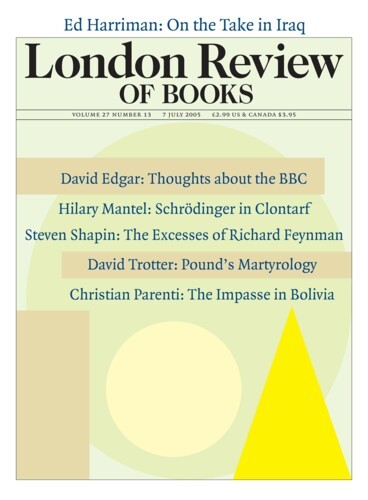The Sun has a knack of dressing up even its most shameless publicity stunts as the performance of its patriotic duty. Last month, the paper carried out yet another variation on its increasingly stale trick of taking a worthless everyday object – a cardboard box; a lump of plasticine – near a member of the royal family. ‘I could have blown Harry to bits,’ the front-page headline proclaimed. ‘Sun man gets “bomb” into Sandhurst.’ A very low-resolution picture, taken by the Sun man’s hidden camera, showed a bunch of cadets, the head of one of them ringed in red. This, apparently, is Prince Harry, though the quality of the image is so poor it could be anyone, and Clarence House has plausibly denied that it’s the prince. The intrepid reporter, who ‘strolled unchallenged around the military academy in Surrey for SEVEN HOURS’, is known only as ‘The Investigator’. His anonymity didn’t prevent him getting a byline photo (everyone needs a byline photo these days), though to protect his identity his features were pixellated – reducing, as it happens, the resolution of his mugshot to more or less the same level as that of his secret pictures of the cadets.
The hysterics continued inside the paper: a double-page spread describing The Investigator’s day out was underpinned by a few stern words from Andy McNab (‘Gulf War hero and ex-SAS man’); a severe and self-congratulatory leader reminded readers that ‘this is the third time the Sun has planted a “bomb” at the heart of a supposedly ultra-secure zone.’ If The Investigator ‘had been a terrorist, the third in line to the throne could have been dead by now’. These concerns were echoed by the half-naked woman on page three. Zoe, 24, from London, was apparently ‘appalled that a Sun reporter managed to walk around unchallenged. He could have been a terrorist.’
Except he wasn’t. And when you think about the whole ‘could have’ aspect of the infiltration, the threat evaporates. I ‘could have’ killed a significant proportion of the population of London: ‘LRB man gets “anthrax” onto Tube. An LRB reporter with “anthrax” gained easy access to the London Underground – and could have infected everyone on the train. Our man, known as “The Assistant Editor”, strolled unchallenged around Tottenham Court Road Station for SEVEN MINUTES simply by posing as a commuter. He was carrying a fake disease. This is the third time he has breathed at the heart of London’s transport system. If he had been infected with anthrax, a third of his fellow passengers could be dead by now.’
The Sun’s ‘fake bomb’ consisted of an alarm clock, a battery and a lump of plasticine in a small tupperware box. It was utterly unbomblike, as was the cardboard box with the word ‘bomb’ written on it that the paper took into Windsor Castle in the back of a van. The Investigator got into Sandhurst by applying to visit the library, which is open to the public by appointment. There’s no way of knowing whether or not any security checks were run on him, since if he was checked out, he would have been seen not to be a risk, because he wasn’t. It’s not true that he ‘could have blown Harry to bits’, because he didn’t have anything to blow him to bits with. The security services are on the look out for terrorists, not journalists. All the same, ‘furious’ John Reid, the defence secretary, has ordered an investigation.
Let’s assume for a moment that the male line of the monarchy is under threat. How to safeguard it? Perhaps a royal sperm bank is in order. There used to be one for the seed of Nobel Prize winners. In The Genius Factory: Unravelling the Mysteries of the Nobel Prize Sperm Bank (Simon and Schuster, £12.99), David Plotz investigates the Repository for Germinal Choice that was founded in California in 1980 by Robert Graham, an ‘eccentric millionaire’, and closed in 1999. The only prize-winner to fess up to having donated was William Shockley, who invented the transistor. He also thought people with an IQ of less than 100 should be paid to undergo voluntary sterilisation. The Repository resulted in two hundred children. The original idea was that only women with an IQ of 120 or more would be able to apply for sperm, but Graham soon abandoned that requirement in favour of any married woman with an infertile husband.
It’s early days: even Paul Dirac didn’t win the Nobel Prize till he was 31. But I wouldn’t bet on the two hundred being more successful – whatever that means – as a whole than a random sample of two hundred people. It takes a lot more than sperm from a previous winner to make a Nobel laureate. Happily, however, it’s more than enough to make a king (and possibly a Sun Investigator, too): in fact, so long as one’s mother is a queen (or princess), it doesn’t really matter whose sperm is involved. Still, I look forward, once the Ministry of Defence has finished its investigation, to the state opening of the Royal Repository.
Send Letters To:
The Editor
London Review of Books,
28 Little Russell Street
London, WC1A 2HN
letters@lrb.co.uk
Please include name, address, and a telephone number.

